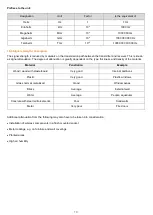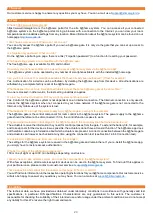
18
16. Basic information about wireless installations
The aim of the following information is to provide a basic overview of the technology and functions involved in wireless
transmission in the b@home system and to assist with planning the assembly of individual components.
16.1 Radio waves
Wireless signals are electromagnetic waves, which spread equally in all directions at the speed of light. Electromagnetic
waves include radio waves, microwaves, infrared radiation, visible light, UV radiation, X-ray radiation and gamma
radiation. The various types of waves differ in terms of their frequency and therefore their wavelength.
In contrast to light waves, radio waves can penetrate walls, ceilings and furniture.
The field strength of radio waves decreases quadratically as the distance between the transmitter and receiver increases,
i.e. if the distance between the transmitter and receiver doubles, the signal is just a quarter of its original strength.
16.2 Frequency band
Frequency ranges are assigned by the German Federal Network Agency. There are specified frequency ranges for every
application, e.g. for radio, TV, amateur radio, aircraft radio, taxi radio, police radio or mobile radio. There are specified
distances between these frequency ranges to prevent overlaps and resulting transmission issues.
Wireless components from alre transmit in what is known as the ISM range (Industrial, Scientific and Medical) with a
frequency of 868.3 MHz. This range has been allocated for high-frequency devices in industry, science and medicine but
also for domestic applications.
Using this range, b@home components operated in an open area can achieve ranges of at least 150 metres and in
buildings up to 30 metres.
The maximum permitted transmission power in this range within the milliwatt range is 10 mW. By way of comparison,
mobile phones work continuously with peak power outputs of up to 2000 mW.
Examples of frequency ranges:
Designation
Abbreviation Frequency range
Wavelength
Example application
Low frequency
LF
3 Hz – 3 kHz
100 000 – 100 km
Line voltage (50 Hz)
Long waves
LW
30 – 300 kHz
10 – 1 km
Long-wave radio
Medium waves
MW
0.3 – 3 MHz
1000 – 100 m
Medium-wave radio
Short waves
SW
3 – 30 MHz
100 – 10 m
Short-wave radio
Ultra short wave
USW
30 – 300 MHz
10 – 1 m
USW radio, TV, aircraft radio
Ultra-high
frequency
UHF
0.3 – 3 GHz
10 – 1 dm
WLAN, Bluetooth, DVB-T
Super high
frequency
SHF
3 – 30 GHz
10 – 1 cm
Radar, WLAN
Infrared radiation
IR
0.3 – 385 THz
0.78 – 1000 µm
Temperature measurements
Visible light
VIS
385 – 750 THz
400 – 780 nm
Lighting, optical fibres
Explanation
The Hertz unit:
•
Named after the physicist Heinrich Hertz
•
Number of recurring processes in one periodic signal per second.
•
In antenna technology, this describes the number of recurring vibrations (positive and negative half-waves).
•
Wireless or radio waves are stated using this unit as are sound waves in acoustics, for example







































